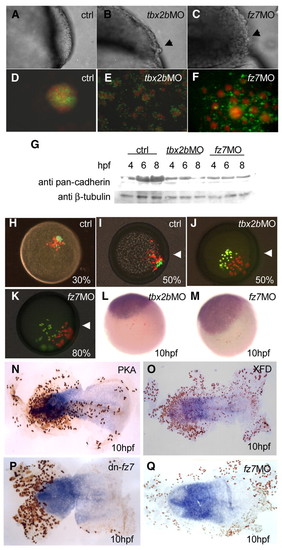
Early function of Tbx2b and Fz7 is required for cell adhesion. The smooth surface of (A) a wild-type gastrulating embryo, is in contrast to the `rough phenotype' (black arrows) in (B) Tbx2b and (C) Fz7 morphants. (D) In control, dissociated 6 hpf cells labelled with fluorescein (green) and Texas Red (red) formed a single aggregate after 24 hours in hanging drop culture. By contrast, cells derived from fluorescein-labelled (E) Tbx2b- and (F) Fz7-morphant cells formed single layer shells around wild-type Texas Red-labelled aggregates. (G) Western blot with a pan-cadherin antibody showed that the level of cadherins in Tbx2b and Fz7 morphants remained the same or declined in contrast to the control. (H-M) Cell movement during gastrulation was affected in Fz7- or Tbx2b-deficient cells. Control cells with fluorescein and Texas Red transplanted into wild-type host at (H) 30% epiboly co-migrated towards the dorsal side by (I) 50% epiboly, but fluorescein labelled (J) Tbx2b and (K) Fz7 morphant cells were unable to migrate (white arrowheads indicate position of the shield). A 10 hpf embryo stained for fluorescein (brown) shows that transplanted (L) Tbx2b and (M) Fz7 morphant cells were excluded from the sox19-positive neural plate. (N-Q) Flat mounts of 10 hpf embryos, double stained for fluorescein (brown) and sox19 (blue), after single cell injection at 16-cell stage with (N) PKA, (O) XFD, (P) dn-Fz7 and (Q) fz7 MO.
|

